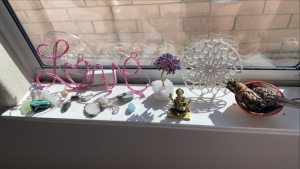
Between videos of Charli D’amelio doing the “Renegade,” or Pudgy the Chihuahua giving us a good ‘ol “owa owa,” you’ve been bound to come across the occasional tarot reading, cutting ties ritual, crystal healing, or any other form of witchcraft during your time on TikTok.
And during your time at Chapman, you’ve been bound to come into contact with a witch. Not on a broomstick, not in front of a cauldron, but probably in Argyros Forum or in your Food Science class.
Maybe some of you won’t buy it, but witchcraft nowadays has become a kind of normalcy in the world. And at Chapman, too.
Junior Abby Haralson is not a witch. However, through TikTok, she became fascinated in the ideals and practices of witchcraft.
“It will normally come up as tarot reading videos and then, like, segway into different TikToks of spells: like cord-cutting rituals and shit, to different tea/potions and different properties of herbs,” said Haralson.
However, not everyone is under witch-tok’s spell. For many, it’s an entertaining, one-minute clip of nonsense to scroll past and continue on with your day.
“I don’t understand any of it,” junior Michael McCall said. “It’s just entertaining to witness.”
As of March 2021, #witchtok has over 10.5 billion views.
Take a dive into the hashtag you’ll find content straight out of the 1993 film, Hocus Pocus: black cats, spell jars, incense, white sage, candlelit seances, and even a fair share of voodoo. It is no denying that this ancient craft has inspired a new generation of “baby witches” and a resurgence of the dark arts.
Junior Faith Kelly, as it happens, is a witch. A witch-toker, at that.

In October, Kelly dove headfirst into the world of witch-tok in tandem with her best friend Rylee Winters and launched her very own TikTok account centering around spell-work: casting circles, written and verbal spells, and spell candles and jars. Kelly and Winter’s account is quickly growing with almost 8,000 total likes on their joint account, “Gwen and Moon Tarot.”
“We wanted a way to share helpful information that is understandable for people who are new to spirituality and also those who have been practicing for years,” Kelly said.
While witchcraft can seem like a sub-cultured, trendy niche, there are Chapman students and alumni who have been practicing forms of witchcraft for years.

Senior Emily Locy recognized her identity as a witch in 2017. However, she didn’t fully tap into practicing until July 2020, where she began experimenting with kitchen, cosmic, elemental, and ceremonial witchcraft. Combining her “love for Halloween and cooking,” Locy and her sister, Katie, decided to take the plunge into the craft and become witches.
“I have found that witchcraft can be whatever you make it,” Locy said. “And can be in any form that you practice or do repetitively.”
However, this new phenomenon isn’t all sparkling crystals and love potions. As of recently, witch-tok has encountered allegations of racism, white-washing, and cultural appropriation from several disenfranchised groups.
“Witchcraft is such an ancient and sacred practice,” Locy said. “I go about it by trying to research specific materials, processes, and resources before using any of them and, otherwise, sourcing some materials from established, ethical sources.”

Many of the witch-tok discrepancies are around various symbols and supplies that are meaningful in other cultures such as Native and Middle Eastern. Items like white sage are commonly used within the witch community for cleansing negative energy. Although it is a Native farmed product, many corporate giants have taken advantage of the witch-tok trend and, in turn, taken advantage of Native culture.
For instance, in 2018, a “Starter Witch Kit” hit the shelves of Sephora: the kit featured fragrances, a deck of tarot cards, a piece of rose quartz, and dried white sage for smudging. Although the white sage was said to be “grown in the wild in California and is sustainably harvested and sold by Native American owned and operated businesses,” the product was removed shortly after intense social media backlash.

White sage isn’t the only thing that has been turned into a witchy trend. Waist beads were once worn as a symbol in African cultures as a nod to “Hoodoo,” a form of African voodoo brought about through slavery. Now, they’ve been adapted for modern fashion trends.
The Evil Eye, a very powerful symbol of protection in Greek and Middle Eastern cultures, has become a commonly used emoji in the Instagram bios, TikTok captions, and dainty, trendy jewelry throughout social media.
Rox, a Chapman alumni and practicing witch, doesn’t interact much with witch-tok. To her, many members of the community don’t really know what they’re talking about. Even after practicing witchcraft for the past 4 years, Rox is still uncomfortable making videos and sharing her craft with the internet. To her, there’s really no such thing as learning too much.

As a woman of Iranian descent and a witch, Rox finds fault within the Evil Eye trend and the appropriative nature of witchcraft’s rising popularity, especially on social media.
“It’s one thing if you’re gifted these very culturally significant items,” Rox said. “But it’s another to wear them because you think they’re cute or ‘trendy.’”
However, instead of steering people away from practicing witchcraft, Rox encourages baby witches to do their research on the history practices, supplies, and symbols used in witchcraft and to respect their cultural significances.
“I had no idea about the origins of [white] sage and palo santo and, unfortunately, I did use them early in my practice,” said Rox. “But when I learned how important they were in other cultures and stopped right away. It really comes down to being conscious, respectful, and doing your research.”
